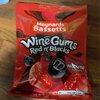E163 - Anthocyanins
Functions: Colour
Anthocyanins -also anthocyans; from Greek: ἄνθος -anthos- "flower" and κυάνεος/κυανοῦς kyaneos/kyanous "dark blue"- are water-soluble vacuolar pigments that, depending on their pH, may appear red, purple, or blue. Food plants rich in anthocyanins include the blueberry, raspberry, black rice, and black soybean, among many others that are red, blue, purple, or black. Some of the colors of autumn leaves are derived from anthocyanins.Anthocyanins belong to a parent class of molecules called flavonoids synthesized via the phenylpropanoid pathway. They occur in all tissues of higher plants, including leaves, stems, roots, flowers, and fruits. Anthocyanins are derived from anthocyanidins by adding sugars. They are odorless and moderately astringent. Although approved to color foods and beverages in the European Union, anthocyanins are not approved for use as a food additive because they have not been verified as safe when used as food or supplement ingredients. There is no conclusive evidence anthocyanins have any effect on human biology or diseases. - Wikipedia
EFSA evaluation: Scientific Opinion on the re-evaluation of anthocyanins -E 163- as a food additive (2013-04-23)
Country: United States - View matching products from the entire world
-
Monster pacific punch - MonsterMonster Energy - 500 ml

-
Gaufres Côte d’Or - Lu
-
Tesco Cherry Bakewell Tarts 6 Pack - six

-
Jelly babies - Bassetts - 190 g

-
Classic - Sugus - 150 g

-
Jam Tarts - Mr Kipling - 6

-
Soft Australian Licorice

-
Lion’s Mane Mushroom - Fungies

-
Tesco Strawberry And Cream Swiss Roll

-
Premium Swedish Cider strawberry-lime - Rekorderlig - 330ml

-
Fondant Icing

-
Mini Birthday Cake Animal Cookies - Benton's - 12 oz

-
Cadbury Dream Rasberry Bites - 130 g

-
Amarena sour black cherries in syrup - Toschi

-
Chocolate and red berry cones

-
Trebar soft furits

-
100% Passion Fruit Juice Blend - Rubicon - 1 L

-
Berry white sticks plant based

-
Maynards midget gems candy - 160 g

-
Miss Jones Baking

-
Sour Cherry Syrup - Galina

-
Wine Gums Sweets Bag - Maynards Bassetts - 190 g

-
Sour Patch Watermelon - Mondelez International - 160g

-
Wine gums - Maynards Bassets - 165 g
-
Carambar candy fruit - 450 g

-
Wine Gums - Maynards Bassetts

-
Bassett's Liquorice Allsorts Travel Pack 800G

-
The natural confectionery co. candy jelly snakes - - 100g

-
Liquorice Allsorts Sweets Bag - - 190 g

-
Ms Mollys Madeira Cake .. -
-
Dairy Milk Marvellous Smashables Jelly Popping Candy - Cadbury - 180 g

-
Tesco Assorted Jam Tarts 6 Pack
-
Mis-Shapes - Cadbury

-
The natural confectionery co. candy jelly snakes - 200 g

-
thing
-
Maynards wine gums candy
-
Tesco Party Cupcakes 12 Pack

-
Tesco 2 Iced Belgian Buns
-
Tesco Free From Cherry Bakewell Tarts 4 Pack
-
Maynards bassetts wine gums candy - Mondelez
-
Bassetts allsorts candy - 165 g
-
Maynards bassetts jelly babies candy
-
Sparkling Pomegranate Juice Drink Can - Rubicon

-
Wine Gums Sweets Roll - Brioche pasquier - 52 g

-
Cadbury chocolate egg - 130 g
-
Maynards sports mixture candy - 190 g
-
Ribena, Concentrate Juice Drink, Blackcurrant - Lbb Imports Llc
-
Tesco Finest White Chocolate And Strawberry Cake
-
Lucozade, energy, sparkling lemon and red berry flavour glucose drink with sugars and sweeteners., pink lemonade
-
Black Jack, Blackjack Chews, Aniseed - Olympic Venture Corporation
-
Soft fruut - 179 g

-
Australia'S Soft Eating Liquorice Flavor Mix - Darrell Lea - 7 oz

-
Strawberry Gum - Trident

-
Maynards wine pastilles candy - 160 g
-
Cadbury mini eggs chocolate eggs mini - 103 g
-
Kids Sweets Bag - Sour Patch Kids - 160g
-
Maynards candy sour patch - 160 g
-
Maynards bassetts

-
Cadbury roses chocolate pieces-assorted
-
hyvee mini muffins - Hy-Vee
-
Cadbury milk tray chocolate pieces milk
-
Cadbury roses chocolate pieces
-
Cadbury roses chocolate pieces - 729 g
-
Cadbury mini eggs chocolate eggs mini
-
Cadbury mini eggs chocolate pieces assorted chocolate
-
Cadbury roses chocolate pieces-assorted
-
Cadbury mini eggs chocolate egg
-
Cadbury mini eggs chocolate eggs mini
-
Party Cake -

-
Dooblz Krokoo'S / Reptiles Gummy Candy - Shneider s

-
Blackcurrant Juice - Ribena - 20.29 fl oz. (600ml)

-
Liquorice allsorts

-
cinnamon
-
Tesco Bakewell Tart 2 Pack
-
Originals python gummy candy - Shneider’s

-
Dinosaurs - The Natural - 200 g

-
Bassetts jelly babies candy berry mix

-
Bubble Monster Pink&Blue 150g - Shneider's

-
Wine gums - 52 g

-
Wine gums - 165 g

-
BLOOD Orange - Lorina - 330 ml / 11,1 Oz

-
Maynards candy

-
Icing on the cake

-
Collins amarena

-
Dooblz drac'kiss gummy candy - Shneider’s

-
Cadbury mini eggs chocolate eggs mini
-
Liquorice Allsorts Sweets Bag - Maynards Bassetts - 400 g

-
Halls candy cherry sugar free - 32 g

-
Bonart Sweeties chewy candy
-
Confetti pop frosting made with coconut oil - Miss Jones

-
Disney Spiderman Celebration Cake
-
Disney Avengers Celebration Cake
-
Pistachio, strawberry, apricot, coconut-passionfruit, black currant & vanilla french macarons, pistachio, strawberry, apricot, coconut-passionfruit, black currant & vanilla
-
Cream Horns - Tesco - 110g (2x55g)

-
Jawbreakers fruity flavored hard candy with a chocolatey center, jawbreakers fruity
-
Amaranth wafers cranberries - Kalan - 2.12 oz (0.13 lb) 60 g

-
Confetti pop
-
Bakewell tart - Mr Kipling
-
Syrup - Marco Polo

-
Jelly babies - 130 g

